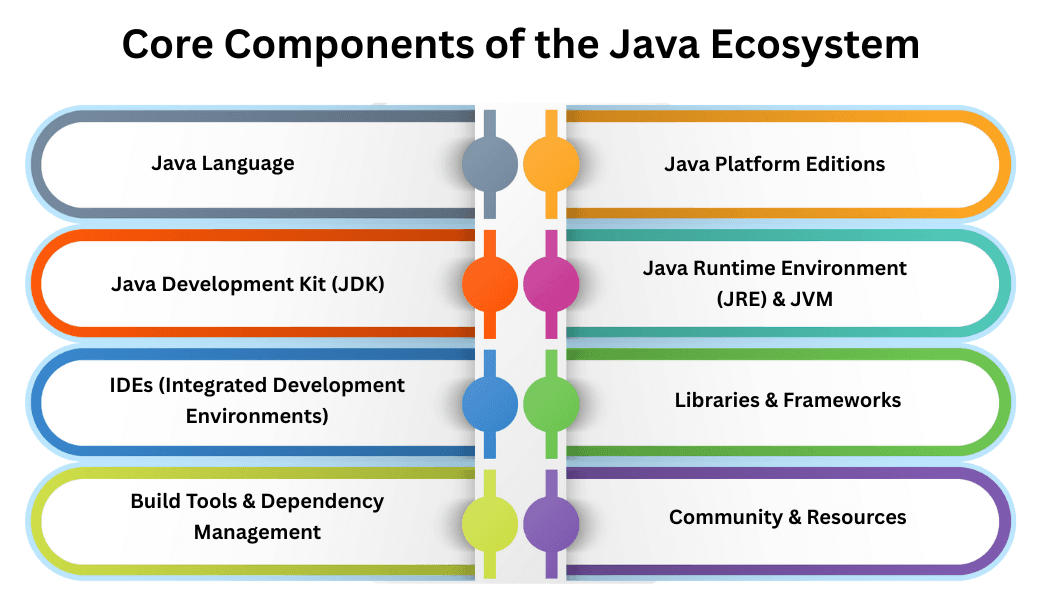Understanding the Java Ecosystem
Java is more than just a programming language. Its ecosystem includes tools, libraries, frameworks, platforms, and community resources that make it one of the most popular and versatile programming environments in the world.
Understanding this ecosystem will help you write better Java programs and choose the right tools for your projects.
What is the Java Ecosystem?
The Java Ecosystem refers to all the components, technologies, and resources that work together to support Java development. It includes:
- Java Language – core syntax, features, and capabilities
- Java Development Kit (JDK) – compiler, libraries, and tools
- Java Runtime Environment (JRE) – JVM for running programs
- Integrated Development Environments (IDEs) – Eclipse, IntelliJ IDEA, NetBeans
- Libraries & Frameworks – Spring, Hibernate, Apache Commons, etc.
- Build Tools & Dependency Management – Maven, Gradle
- Community & Documentation – Oracle docs, Stack Overflow, GitHub
Core Components of the Java Ecosystem

1. Java Language
- Provides syntax, data types, OOP features, and core APIs
- Includes Java SE (Standard Edition) for general-purpose programming
2. Java Platform Editions
- Java SE (Standard Edition): Core language features, collections, I/O, concurrency
- Java EE / Jakarta EE (Enterprise Edition): Web applications, microservices, enterprise APIs
- Java ME (Micro Edition): Mobile, embedded devices, IoT
3. Java Development Kit (JDK)
- Includes compiler (
javac), runtime libraries, and development tools - Necessary for writing, compiling, and running Java programs
4. Java Runtime Environment (JRE) & JVM
- JRE: Provides the environment to run compiled Java programs
- JVM: Converts bytecode to machine code and executes programs on any platform
5. IDEs (Integrated Development Environments)
- Eclipse, IntelliJ IDEA, NetBeans streamline Java development
- Features include syntax highlighting, auto-completion, debugging, and project management
6. Libraries & Frameworks
- Frameworks like Spring, Hibernate, JavaFX, and Struts simplify development
- Libraries provide reusable code for tasks like database access, networking, logging, and testing
7. Build Tools & Dependency Management
- Maven and Gradle automate compilation, testing, packaging, and dependency management
- Useful for large projects and enterprise applications
8. Community & Resources
- Documentation: Oracle Java Docs, API references
- Forums & Q&A: Stack Overflow, Reddit, GitHub
- Open Source Projects: Contribute and learn from real-world projects
How the Java Ecosystem Works Together
[Java Language] → [JDK] → [Bytecode] → [JVM / JRE] → [Platform Execution]
↓
[IDE + Build Tools + Libraries/Frameworks] → Efficient Development
↓
[Community Support + Documentation] → Learning & Troubleshooting
- Code Writing: You write code using Java language and IDEs
- Compilation: JDK compiles code into bytecode
- Execution: JVM runs the bytecode on any platform
- Enhancements: Libraries and frameworks speed up development
- Support: Community and documentation help resolve issues
Visual Diagram – Java Ecosystem Flow
┌────────────────────┐
│ Java Language │
│ (Syntax + Features)│
└────────┬───────────┘
│
▼
┌────────────────────┐
│ JDK │
│(Compiler + Tools) │
└────────┬───────────┘
│
▼
┌────────────────────┐
│ Bytecode (.class)│
└────────┬───────────┘
│
▼
┌────────────────────┐
│ JVM / JRE │
│(Execution Layer) │
└────────┬───────────┘
│
▼
┌──────────────────────────────────────┐
│ IDEs + Build Tools + Libraries + FW │
│ (Eclipse, Maven, Spring, Hibernate) │
└──────────────────────────────────────┘
│
▼
┌────────────────────┐
│ Community & Docs │
│(Oracle, GitHub, SO)│
└────────────────────┘Benefits of Understanding the Java Ecosystem
| Benefit | Description |
|---|---|
| Productivity | IDEs and frameworks simplify coding |
| Portability | JVM ensures cross-platform execution |
| Scalability | Tools and frameworks support large enterprise apps |
| Community Support | Easy access to resources and problem-solving |
| Continuous Learning | Active ecosystem allows growth in Java skills |

